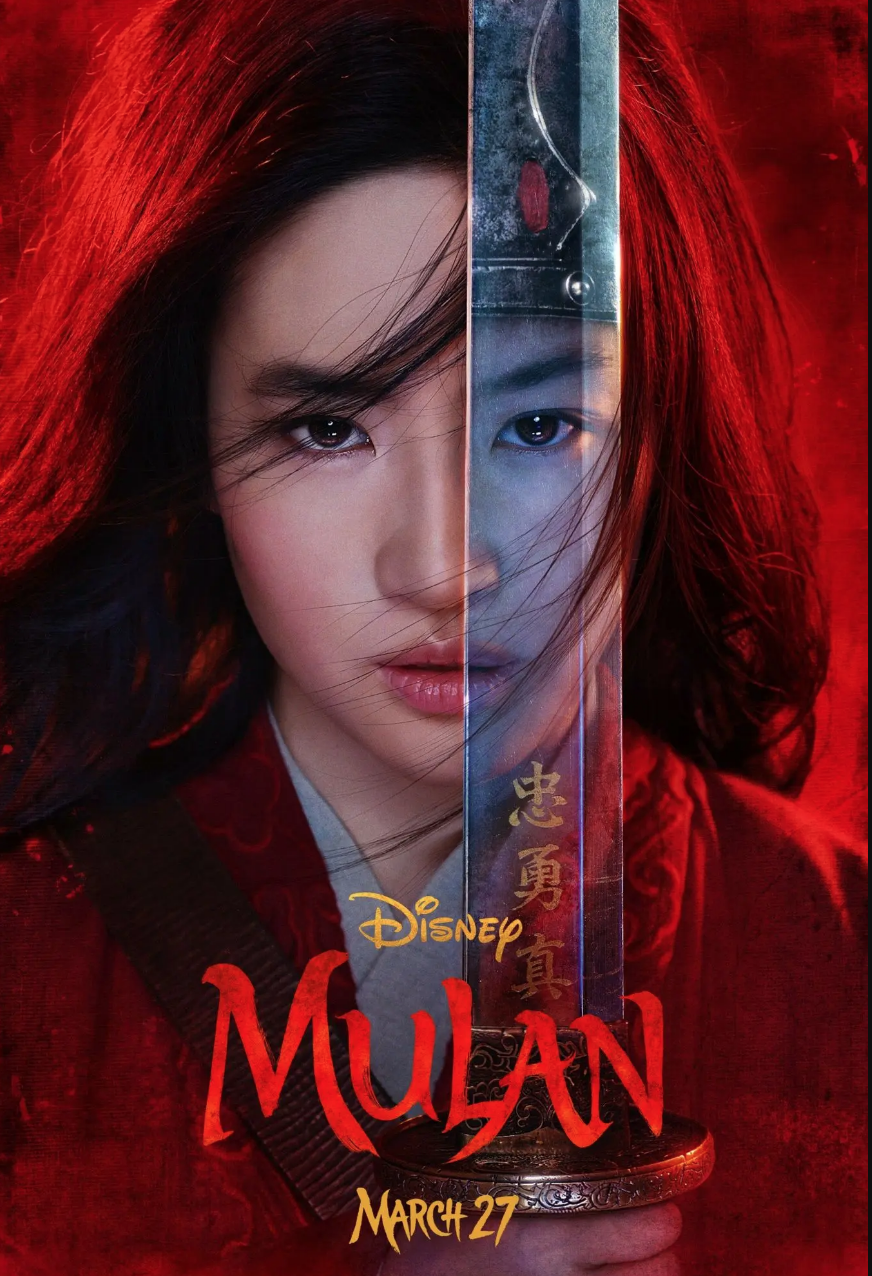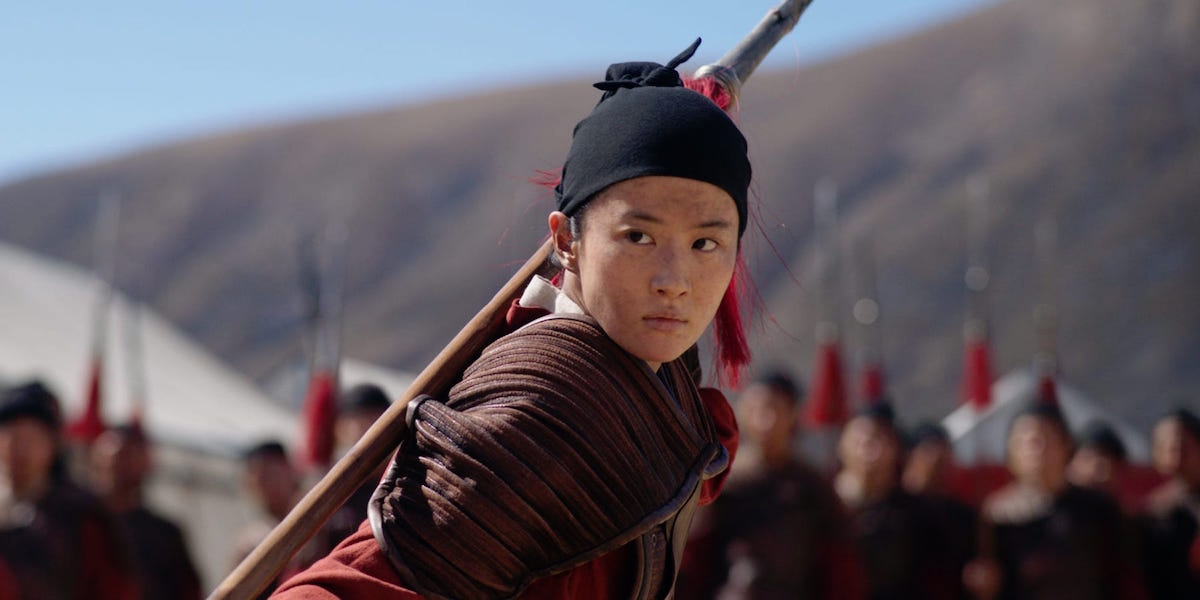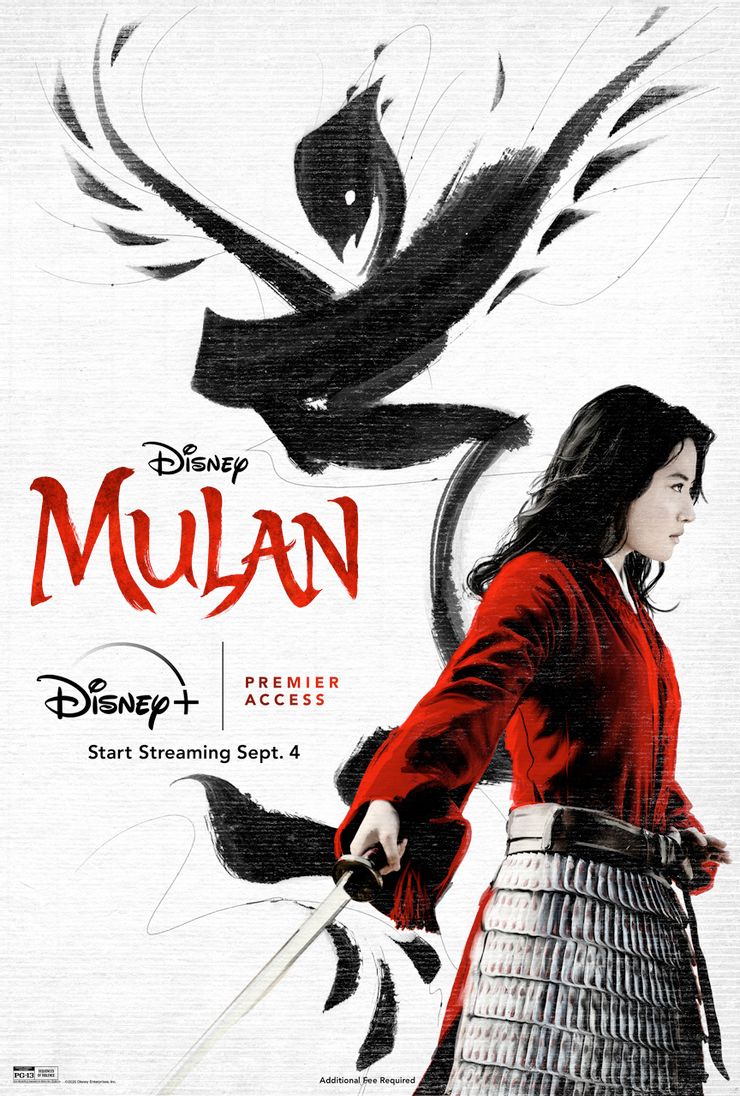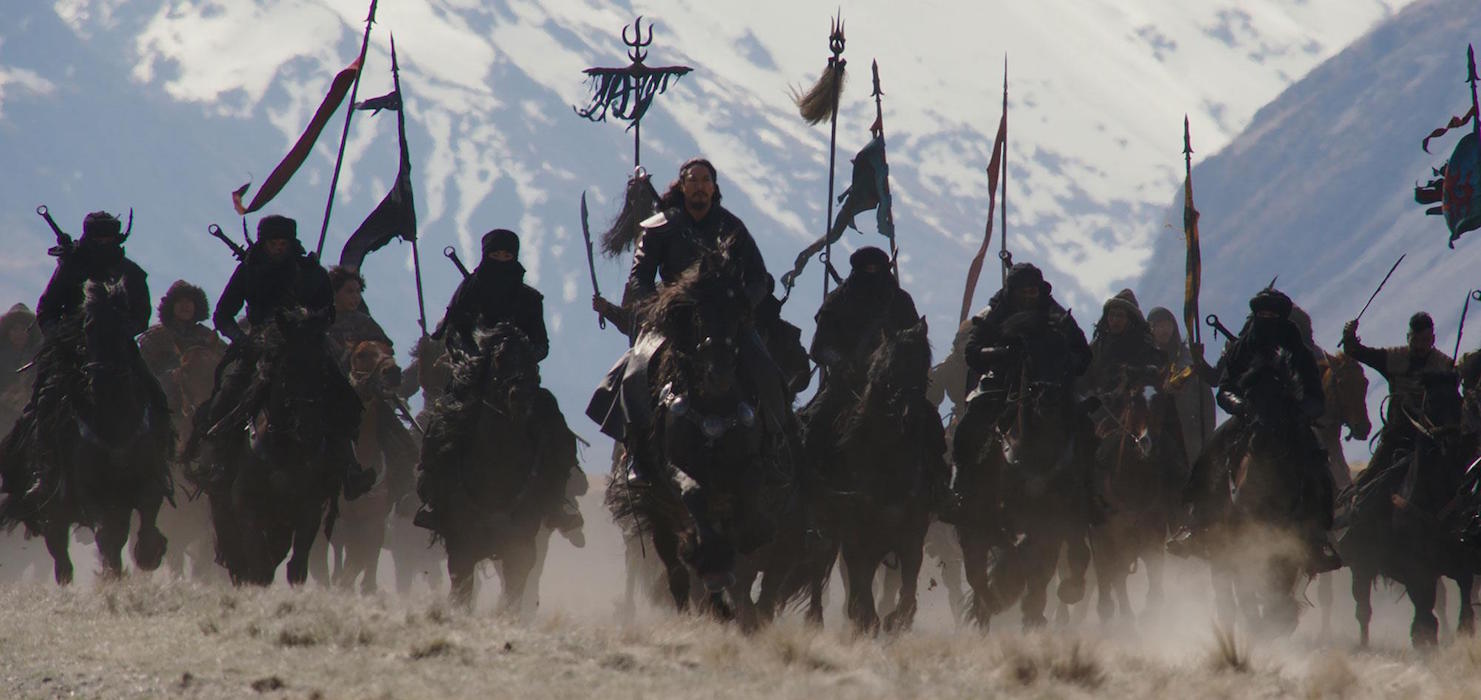by Brian Hioe
語言:
English /// 中文
Photo credit: Mulan/Disney
TO BORROW A phrase commonly used in Chinese Communist Party (CCP) parlance, Disney’s recently released live-action remake of Mulan must have originally seemed like an instance of “win-win cooperation” to Disney and the Chinese government.
As the latest in Disney’s live-action remakes of its animated classics, the film would appeal to lovers of the 1998 animated film in western contexts. Likewise, Disney would be able to pose as progressive on issues of representation in media, with increased attention on Asian American representation in film in past years after the commercial success of films such as Crazy Rich Asians, The Farewell, and Always Be My Maybe.
 Mulan, played by Liu Yifei, disguised as a male soldier. Photo credit: Mulan/Disney
Mulan, played by Liu Yifei, disguised as a male soldier. Photo credit: Mulan/Disney
One notes that the 1998 animated version of Mulan performed poorly in China despite Disney’s hopes for the film to do well in Chinese markets, with backlash by Chinese viewers against what they perceived as cultural inauthenticity. In this respect, Disney executives probably hoped to make good on the aims of the animated original to break into the Chinese market with the live-action remake.
Consequently, to steer the film toward success in Chinese markets, the live-action Mulan was a film produced implicitly in cooperation with Chinese authorities. One can see why the Chinese government would want to promote the film. As a Disney film, the live-action Mulan would allow for a projection of Chinese soft power among western, particularly American audiences—something increasingly a priority for the Chinese government at present.
One notes, then, that for western Disney executives, Mulan was an attempt at breaking into the Chinese market. On the other hand, for the Chinese government, Mulan was an attempt at breaking into western markets. In this way, where the live-action Mulan was concerned, the mutual interest of both sides not only coincided, but proved mirror reflections of each other.
A “Chimeric” Film Emergent from the Complex, Interlocked Relation of America and China
IT MUST HAVE come as some surprise to both parties, then, when the live-action Mulan hit on severe stumbling blocks even before the film’s release. Apart from the COVID-19 pandemic making it impossible to release the film theatrically in most countries, resulting in its release online instead, the film saw calls for a boycott because of stars Liu Yifei and Donnie Yen’s support for the violent actions of the Hong Kong police against pro-democracy protesters over the past year of demonstrations that have taken place in Hong Kong.
After the film’s release, the film has seen further controversy because of that the film was shot in Xinjiang. The shooting process saw the cooperation of the Xinjiang Propaganda Department—which appears in the film’s credits as the Xinjiang Publicity Department, possibly a deliberate mistranslation on Disney’s part—as well as the Turpan Public Security Bureau, which itself directly responsible for Uighur detentions. As over one million Uighurs are currently imprisoned in “reeducation” camps in Xinjiang, with reports of forced sterilizations, this has led to further criticisms of Disney for turning a blind eye to ethnic cleansing to film Mulan.
That the film was shot in Xinjiang and China’s vast detention of Uighurs in the region is aimed at stamping out Islam has also shaped readings of the film. The antagonistic forces in the story, the Rourans, are visually depicted as Middle Eastern, adding “a splash of Islamophobia” to the film, as put by Jeannette Ng in Foreign Policy. The film strives to avoid all mention of Xinjiang by instead referring to vague, nondescript locations such as “Northwestern China” or “The Silk Road.” And, because the historical Rouran Khaganate was a tribal confederation and state founded by proto-Mongolic peoples, this takes on uncomfortable shades in consideration of contemporary efforts by the Chinese government to stamp out Mongolian identity in Inner Mongolia by phasing out Mongolian language teaching in favor of Mandarin, something that has met heated resistance.
Mulan specifically thank the publicity department of CPC Xinjiang uyghur autonomous region committee in the credits.
You know, the place where the cultural genocide is happening.
They filmed extensively in Xinjiang, which the subtitles call “Northwest China”#BoycottMulan pic.twitter.com/mba3oMYDvV
— Jeannette Ng 吳志麗 (@jeannette_ng) September 7, 2020
Photo of the film’s credits, thanking the Xinjiang Propaganda Department
Backlash against the movie has been international, not only in western contexts, but in Asia itself. For example, analysis of tweets about the movie shows that the largest social media influencer tweeting about the movie is Thai student activist Netiwit Chotiphatphaisal. Controversy regarding the film being shot in Xinjiang eventually became large enough that the Chinese government decided to ban all coverage of Mulan in domestic media outlets. Afterward, state-run media sought to cut ties with the film outright.
With greater attention to the geopolitical realities in China behind the production of the film, then, one can breathe a sigh of relief that the film was not uncritically celebrated as a victory for Asian American representation.
Namely, past efforts by the Chinese government at breaking into western markets in cooperation with Hollywood film studios have involved centering white, Hollywood actors alongside Chinese stars in a setting taking place in ancient China. Films in this vein include The Great Wall, Outcast, and Dragon Force. But this has led to strong reactions from Asian Americans, most visibly in backlash against The Great Wall in 2016 with claims that Hollywood studios were responsible for whitewashing by inserting Matt Damon as the star of a film set in ancient China.
What such backlash failed to note was that the film’s Chinese backers—the western companies involved in the film’s production having had a known history of strong ties with the Chinese government—may have inserted Damon in the film to grant the film access to western markets. Notably, the plot of The Great Wall was a starkly Chinese nationalist narrative. Westerners such as Damon’s character were depicted as individualistic imperialists that had no motive other than greedy, personal profit, and who differed from noble and righteous Chinese whose moral virtue stemmed from their loyalty to the nation-state. Much as how Hollywood films have tried to enter the Chinese market by inserting Chinese actors into films but giving them peripheral roles—a practice mocked in China as “flower vasing”—this would be the phenomenon in inverse, by using a western actor.
Yet, noting this controversy, Mulan was careful to steer clear of casting white actors. It may also be worth remarking on that, at 200 million USD, Mulan far surpassed The Great Wall—then the most expensive film ever shot in China—in terms of budget.
In seeing the film’s whitewashing as the result of actions by Hollywood, Asian Americans were arguably centering themselves and their experiences regarding lack of representation in America, rather than grappling with the geopolitical realities in Asia that gave rise to the film—something more remote to many Asian Americans than what was closer to home in America.
 Mulan, played by Liu Yifei, disguised as a male soldier. Photo credit: Mulan/Disney
Mulan, played by Liu Yifei, disguised as a male soldier. Photo credit: Mulan/Disney
Indeed, The Great Wall arguably set the template for Mulan, with much overlap between the two films in terms of underlying political ideology. But does backlash against the live-action Mulan from Asian Americans and others reflect greater awareness of Asian political contexts, rather than only an Asian American context in the four years since The Great Wall controversy?
One questions this, seeing as many have sought to lay blame for Mulan’s faults at the hands of the film’s overwhelmingly non-Chinese Hollywood production crew, as the live-action Mulan’s director and scriptwriters were not Chinese or Asian. Predictably, criticisms have been particularly heated regarding the film’s lack of cultural authenticity.
Certainly, the film rather inaccurately depicts concepts such as “qi” in Sinophone wuxia martial art films, depicting this as a sort of rare power that grants supernatural reflexes, the ability to scale walls, and shapeshift, and somewhat awkwardly claiming in the film that traditionally only men can wield “qi”—despite the numerous female martial artists to be found in wuxia films—and equivocating the supposedly taboo notion of female wielders of qi with the western concept of “witches.” Tropes of the western phoenix, such as that of dying in flame and being reborn after death, are incorporated into the fenghuang, because the Chinese mythological bird is often referred to as a “phoenix” in English translation.
Chinese geography is depicted rather strangely in the film, with characters traveling vast distances from Beijing to China’s western peripheries seemingly overnight, compressing China into bite-size for foreign audiences who would not have any sense of the relative geographic proximity of Chinese regions. Likewise, the film rather promiscuously draws from Chinese history to create a concocted, imaginary vision of history, as observed in the costumes seen in the film or the architectural style of the buildings that appear in it.
Yet lambasting the film for cultural inauthenticity—and solely blaming the Hollywood production crew—may not be the most productive point to criticize the film on.
Perhaps the more productive understanding of the film would not be to focus solely on issues of authenticity or try to lay blame for how the film turned out at either Hollywood or China’s feet. Instead, it would be to see Mulan as a film reflective of the chimeric, interlocked relation of the Chinese and American economies that came to exist over the past two decades. Indeed, at the time the film was first announced, the film was seen as reflective of how the mutually dependent relation of the Chinese and American economies would cause the culture industries of both superpowers to become increasingly linked.
 Film poster. Photo credit: Mulan/Disney
Film poster. Photo credit: Mulan/Disney
It is up in the air whether this is still the case, due to the ongoing US-China trade war and what some have labeled a “new Cold War” between the two superpowers. It is now debated whether “Chimerica”—referring to the economic symbiosis of China and America that developed over the last two decades—is dead or not, with efforts by China and America to economically decouple from each other. But either way, Mulan proves a highly “Chimeric” film, as a film engendered by the past decades of the fraught, co-dependent relation between the US and China—something particularly salient given the authoritarian lurch of both countries at present and convergent behavior between the two superpowers.
Nationalist, Statist, and Patriarchal Ideological Underpinnings to Mulan
CONSEQUENTLY IN evaluating the live-action Mulan, what strikes above all else is that the film is a highly Orientalist one. However, this is not merely the Orientalist gaze of westerners onto China, say, but also the embrace of Orientalist tropes in efforts by the contemporary Chinese government in the depiction of itself that it hopes to project abroad; Orientalism and self-Orientalism came to overlap in the film.
So can one understand the constant refrains regarding honor and self-sacrifice in the live-action Mulan, with the eponymous protagonist forever intoning the need to be loyal to the family, emperor, and nation. These are reflective of many Orientalist views of a reified notion of Chinese culture, as well as reflective of how Chinese nationalists themselves have sometimes articulated what they see as the unbridgeable cultural and civilizational gulf between their own reified notion of China and an equally reified notion of the West.
To this extent, the film’s Orientalist underpinnings are deeply bound up with the film’s highly nationalist and statist ideology—reflective of authoritarian iterations of contemporary Chinese nationalism. A significant contrast between the 1998 animated Mulan and the 2020 live-action remake, for example, is in its depiction of the Chinese Emperor. While in both versions, the Emperor is depicted as a just and wise ruler, in the 1998 animated film, he was an elderly, sage-like, figure prone to uttering gnomic aphorisms.
By contrast, as played by Jet Li in the 2020 live-action film, the Chinese Emperor is a decidedly martial figure. Not only did the Emperor personally kill the father of antagonist Bori Khan—the leader of the Rourans—in battle, but near the end of the film, he proves willing to take on Khan personally in a duel. It is the Emperor that ultimately lets loose the arrow that Mulan kicks and drives into Khan’s body using her qi powers, killing him.
No questions are ever raised regarding the moral ambiguity of that Khan’s antagonism toward the Emperor stems from the fact that the Emperor killed Khan’s father and took his lands, and that Khan seeks revenge because of this—in effect, Rouran actions are a response to prior Han aggression. Nevertheless, the film decides to blithely depict the Chinese Han in a positive light and the Rourans in a negative light rather than attribute any complex or sympathetic motivations to the Rourans.
 Depiction of the Rourans, with their leader Bori Khan, played by Jason Scott Lee, in the center. Photo credit: Mulan/Disney
Depiction of the Rourans, with their leader Bori Khan, played by Jason Scott Lee, in the center. Photo credit: Mulan/Disney
Again, this creates troubling readings in the present, given the current mass imprisonment of Uighurs in Xinjiang as an attempt to eradicate Islam and efforts by the Chinese government to erase Mongolian cultural identity. But one notes the implicit contrast in the film between the city-based and bureaucratic Han and the nomadic, horse-riding Rourans, which call to mind James Scott’s arguments in The Art of Not Being Governed regarding the need of states to subjugate nomadic, stateless peoples. Such parallels cannot help but further drive home the authoritarian, statist undertones of the film.
Another significant difference between the 1998 animated film and the 2020 live-action remake proves the introduction of a new, female character, Xianniang, played by Gong Li. Xianniang is depicted as having been cast out by other Chinese Han because of her strong qi powers, powers shared by Mulan. She begins the film allied with Bori Khan. Xianniang’s loyalty to Khan is based on the fact that Khan promises to create a society where she will not be an outcast, as a powerful woman.
But by the film’s end, Xianniang betrays Khan, leading Mulan to where Khan plans to execute the Chinese emperor and sacrificing herself to protect Mulan. In having a last-minute change of heart that results in her sacrificing herself to save the protagonist, Xianniang proves to be something like a Darth Vader figure for Mulan, as a secondary antagonist whose sudden heel turn assures the defeat of the primary antagonist.
Xianniang is apparently inspired to do this after seeing Mulan having won the loyalty of the imperial army. Seeing that a woman can, in fact, become accepted by Chinese Han society through skill and martial prowess leads her to suddenly give up on dreams of overturning that order and establishing a more egalitarian one. This is the supposedly feminist ideology which in our modern capitalist context celebrates female CEOs who have made it in a male-dominated world to dismiss calls for radical change to overturn patriarchy, perhaps—just transposed to an imagined version of Chinese antiquity.
Indeed, though the film seems to want to vaguely depict Mulan as a feminist figure in this light, Mulan can instead be seen as a figure fundamentally defined by loyalty to the heteropatriarchal order of the Chinese empire, which has the male martial figure of the Emperor at the apex of this order. Mulan is eventually permitted a place in this heteropatriarchal order, because of her supernatural prowess as a warrior, and accorded honors within it after she saves the emperor and assists in the defeat of Bori Khan. Yet she ultimately is not one to call for a shift in that order, but in fact embraces apologia for this order, as an exception allowed an exceptional place within the heteropatriarchal order by virtue of extraordinary skill. As such, even after being praised by the emperor, Mulan continues to insist that she must return home in order to face the discipline of her family, if need be.
 Xianniang, played by Gong Li. Photo credit: Mulan/Disney
Xianniang, played by Gong Li. Photo credit: Mulan/Disney
This is, in fact, is a difference from the 1998 animated version of the film, in which the Chinese Emperor is moved to try and name Mulan a member of his council—a first, seeing as there are no female council members—after she saves him, overruling the objections of his advisers. This conclusion suggests that Mulan’s actions ultimately result in the change of the status quo, resulting in an improved lot for women in imperial China. By contrast, the 2020 Mulan’s actions seem to be aimed at maintaining the existing status quo despite having been on the receiving end of discrimination from it. And Mulan desires to return home, rather than take up an official position in the 1998 animated film simply to be with her family, not because of some desire to face and be subject to familial authority as in the 2020 live-action film.
In the live-action film, Mulan hardly proves a liberatory figure where sexuality and gender is concerned—something bitterly ironic for a film that is the most expensive film ever directed by a female director. Indeed, the film even seems to suggest that a great deal of Mulan’s virtue comes from her chasteness and innocence, rather than her being an independent, strong-spirited personality.
As has been noted, queer readings of Mulan have been carefully erased from the live-action versions, with the removal of plot elements that allow Mulan to be read as queer allegory, and the removal of the character of Li Shang, who has been read as a bisexual character. The film is careful to avoid any hint of interest in Mulan from her love interest in the film, Honghui, before he realizes that she is, in fact, not a man. This shift is not altogether not surprising for a film that aspired to break into the Chinese market, as in the past few years, the Chinese government has banned or censored depictions of homosexuality in television and film, and conducted a political crackdown on Chinese feminists, LGBTQ activists, and others that has had a chilling effect on the Chinese queer cinema scene, along with independent film as a whole, and the cancellation of long-running Pride parades.
The live-action Mulan, then, proves in content and form a film that is apologia for the status quo, and a defense of an authoritarian social hierarchy. Given the geopolitical social context from which the film arose—as a film that originated through efforts by American companies to enter the Chinese market and by the Chinese party-state to project soft power abroad—this should not surprise.

